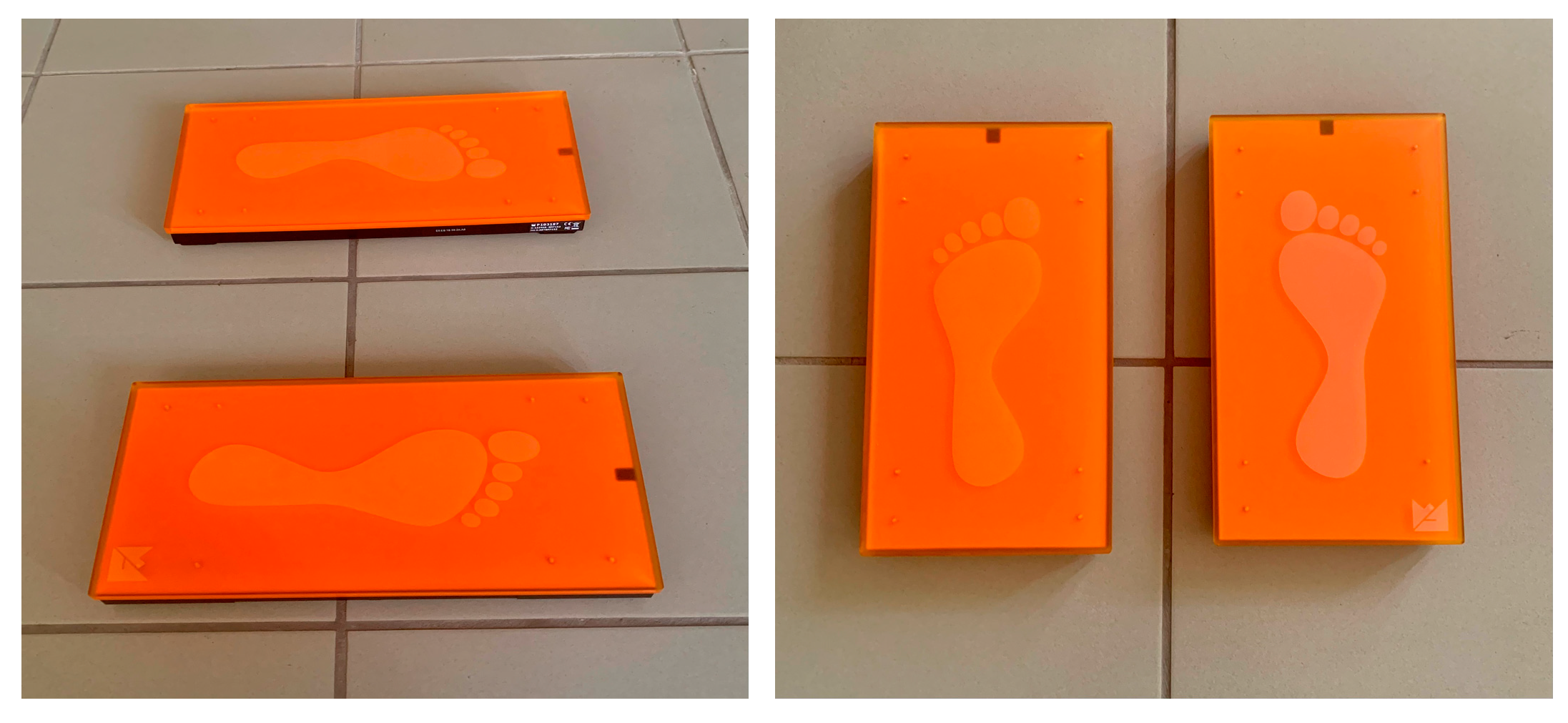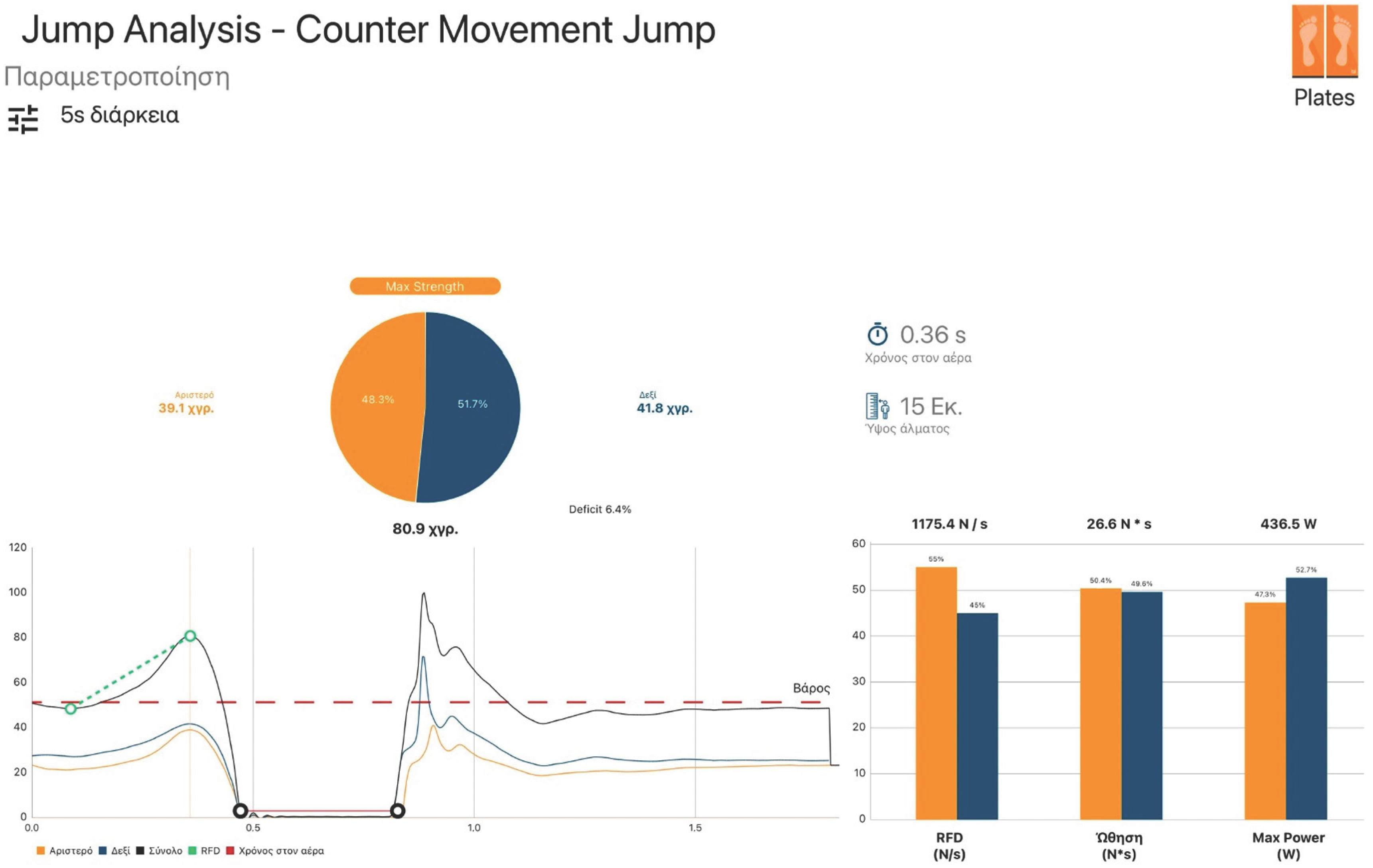Reliability and Validity of the Portable KForce Plates for Measuring Countermovement Jump (CMJ)
Abstract
:1. Introduction
2. Materials and Methods
2.1. Participants
2.2. Procedures
2.3. Countermovement Jump Performance
2.4. Main Outcome Measures
2.4.1. KForce Plates System
2.4.2. My Jump 2 Application
2.5. Statistical Analysis
3. Results
3.1. Reliability
3.2. Concurrent Validity
4. Discussion
5. Conclusions
Author Contributions
Funding
Institutional Review Board Statement
Informed Consent Statement
Data Availability Statement
Acknowledgments
Conflicts of Interest
References
- Petrigna, L.; Karsten, B.; Marcolin, G.; Paoli, A.; D’Antona, G.; Palma, A.; Bianco, A. A Review of Countermovement and Squat Jump Testing Methods in the Context of Public Health Examination in Adolescence: Reliability and Feasibility of Current Testing Procedures. Front. Physiol. 2019, 10, 1384. [Google Scholar]
- Aughey, R.J.; Buchheit, M.; Garvican-Lewis, L.A.; Roach, G.D.; Sargent, C.; Billaut, F.; Varley, M.C.; Bourdon, P.C.; Gore, C.J. Yin and yang, or peas in a pod? Individual-sport versus team-sport athletes and altitude training. Br. J. Sport. Med. 2013, 47, 1150–1154. [Google Scholar] [CrossRef]
- Sole, S.; Ramírez-Campillo, R.; Andrade, D.C.; Sanchez-Sanchez, J. Plyometric jump training effects on the physical fitness of individual-sport athletes: A systematic review with meta-analysis. PeerJ 2021, 9, e11004. [Google Scholar] [PubMed]
- Bazyler, C.D.; Abbott, H.A.; Bellon, C.R.; Taber, C.B.; Stone, M.H. Strength training for endurance athletes: Theory to practice. Strength Cond. J. 2015, 37, 1–12. [Google Scholar]
- Suchomel, T.J.; Nimphius, S.; Stone, M.H. The Importance of Muscular Strength in Athletic Performance. Sport. Med. 2016, 46, 1419–1449. [Google Scholar]
- Seitz, L.B.; Reyes, A.; Tran, T.T.; de Villarreal, E.S.; Haff, G.G. Increases in Lower-Body Strength Transfer Positively to Sprint Performance: A Systematic Review with Meta-Analysis. Sport. Med. 2014, 44, 1693–1702. [Google Scholar]
- Comfort, P.; Stewart, A.; Bloom, L.; Clarkson, B. Relationships between strength, sprint, and jump performance in well-trained youth soccer players. J. Strength Cond. Res. 2014, 28, 173–177. [Google Scholar] [PubMed]
- Sargent, D.A. The Physical Test of a Man. Am. Phys. Educ. Rev. 1921, 26, 188–194. [Google Scholar] [CrossRef]
- Sargent, L.W. Some Observations on the Sargent Test of Neuromuscular Efficiency. Am. Phys. Educ. Rev. 1924, 29, 47–56. [Google Scholar] [CrossRef]
- Anicic, Z.; Janicijevic, D.; Knezevic, O.M.; Garcia-Ramos, A.; Petrovic, M.R.; Cabarkapa, D.; Mirkov, D.M. Assessment of Countermovement Jump: What Should We Report? Life 2023, 13, 190. [Google Scholar]
- McMahon, J.J.; Murphy, S.; Rej, S.J.E.; Comfort, P. Countermovement-Jump-Phase Characteristics of Senior and Academy Rugby League Players. Int. J. Sport. Physiol. Perform. 2017, 12, 803–811. [Google Scholar] [CrossRef] [PubMed]
- Claudino, J.G.; Cronin, J.; Mezêncio, B.; McMaster, D.T.; McGuigan, M.; Tricoli, V.; Amadio, A.C.; Serrão, J.C. The countermovement jump to monitor neuromuscular status: A meta-analysis. J. Sci. Med. Sport 2017, 20, 397–402. [Google Scholar] [CrossRef]
- Lake, J.P.; Mundy, P.D.; Comfort, P.; Suchomel, T.J. Do the peak and mean force methods of assessing vertical jump force asymmetry agree? Sport. Biomech. 2020, 19, 227–234. [Google Scholar] [CrossRef] [PubMed]
- Berton, R.; Lixandrão, M.E.; Pinto e Silva, C.M.; Tricoli, V. Effects of weightlifting exercise, traditional resistance and plyometric training on countermovement jump performance: A meta-analysis. J. Sport. Sci. 2018, 36, 2038–2044. [Google Scholar] [CrossRef]
- Balsalobre-Fernández, C.; Glaister, M.; Lockey, R.A. The validity and reliability of an iPhone app for measuring vertical jump performance. J. Sport. Sci. 2015, 33, 1574–1579. [Google Scholar] [CrossRef]
- Bogataj, Š.; Pajek, M.; Hadžić, V.; Andrašić, S.; Padulo, J.; Trajković, N. Validity, reliability, and usefulness of my jump 2 app for measuring vertical jump in primary school children. Int. J. Environ. Res. Public Health 2020, 17, 3708. [Google Scholar] [CrossRef] [PubMed]
- Walsh, M.; Church, C.; Hoffmeister, A.; Smith, D.; Haworth, J. Validation of a Portable Force Plate for Evaluating Postural Sway. Percept. Mot. Skills 2021, 128, 191–199. [Google Scholar] [CrossRef] [PubMed]
- Choukou, M.A.; Laffaye, G.; Taiar, R. Reliability and validity of an accele-rometric system for assessing vertical jumping performance. Biol. Sport 2014, 31, 55–62. [Google Scholar] [CrossRef]
- Glatthorn, J.F.; Gouge, S.; Nussbaumer, S.; Stauffacher, S.; Impellizzeri, F.M.; Maffiuletti, N.A. Validity and reliability of optojump photoelectric cells for estimating vertical jump height. J. Strength Cond. Res. 2011, 25, 556–560. [Google Scholar] [CrossRef] [PubMed]
- Meras Serrano, H.; Mottet, D.; Caillaud, K. Validity and Reliability of Kinvent Plates for Assessing Single Leg Static and Dynamic Balance in the Field. Sensors 2023, 23, 2354. [Google Scholar] [CrossRef] [PubMed]
- Jimenez-Olmedo, J.M.; Pueo, B.; Mossi, J.M.; Villalon-Gasch, L. Reliability of My Jump 2 Derived from Crouching and Standing Observation Heights. Int. J. Environ. Res. Public Health 2022, 19, 9854. [Google Scholar] [CrossRef] [PubMed]
- Haynes, T.; Bishop, C.; Antrobus, M.; Brazier, J. The validity and reliability of the My Jump 2 app for measuring the reactive strength index and drop jump performance. J. Sport. Med. Phys. Fitness 2019, 59, 253–258. [Google Scholar] [CrossRef] [PubMed]
- Driller, M.; Tavares, F.; McMaster, D.; O’Donnell, S. Assessing a smartphone application to measure counter-movement jumps in recreational athletes. Int. J. Sport. Sci. Coach. 2017, 12, 661–664. [Google Scholar] [CrossRef]
- Cruvinel-Cabral, R.M.; Oliveira-Silva, I.; Medeiros, A.R.; Claudino, J.G.; Jiménez-Reyes, P.; Boullosa, D.A. The validity and reliability of the “My Jump App” for measuring jump height of the elderly. PeerJ 2018, 2018, e5804. [Google Scholar] [CrossRef]
- Gallardo-Fuentes, F.; Gallardo-Fuentes, J.; Ramírez-Campillo, R.; Balsalobre-Fernández, C.; Martínez, C.; Caniuqueo, A.; Cañas, R.; Banzer, W.; Loturco, I.; Nakamura, F.Y.; et al. Intersession and intrasession reliability and validity of the my jump app for measuring different jump actions in trained male and female athletes. J. Strength Cond. Res. 2016, 30, 2049–2056. [Google Scholar] [CrossRef]
- Gahercole, R.; Sporer, B.; Stellingwerff, T. Countermovement Jump Performance with Increased Training Loads in Elite Female Rugby Athletes. Int. J. Sport. Med. 2015, 36, 722–728. [Google Scholar]
- Bosco, C.; Luhtanen, P.; Komi, P.V. A simple method for measurement of mechanical power in jumping. Eur. J. Appl. Physiol. Occup. Physiol. 1983, 50, 273–282. [Google Scholar] [CrossRef]
- Koo, T.K.; Li, M.Y. A Guideline of Selecting and Reporting Intraclass Correlation Coefficients for Reliability Research. J. Chiropr. Med. 2016, 15, 155–163. [Google Scholar] [CrossRef] [PubMed]
- Bland, J.M.; Altman, D. Statistical Methods for Assessing Agreement between Two Methods of Clinical Measurement. Lancet 1986, 327, 307–310. [Google Scholar] [CrossRef]
- Sha, Z.; Zhou, Z.; Dai, B. Analyses of Countermovement Jump Performance in Time and Frequency Domains. J. Hum. Kin. 2021, 78, 41–48. [Google Scholar] [CrossRef] [PubMed]
- Rogers, S.A.; Hassmén, P.; Hunter, A.; Alcock, A.; Crewe, S.T.; Strauts, J.A.; Gilleard, W.L.; Weissensteiner, J.R. The Validity and Reliability of the MyJump2 Application to Assess Vertical Jumps in Trained Junior Athletes. Meas. Phys. Educ. Exerc. Sci. 2019, 23, 69–77. [Google Scholar] [CrossRef]
- Yingling, V.R.; Castro, D.A.; Duong, J.T.; Malpartida, F.J.; Usher, J.R.; Jenny, O. The reliability of vertical jump tests between the Vertec and My Jump phone application. PeerJ 2018, 6, e4669. [Google Scholar] [CrossRef]
- Rago, V.; Brito, J.; Figueiredo, P.; Carvalho, T.; Fernandes, T.; Fonseca, P.; Rebelo, A. Countermovement jump analysis using different portable devices: Implications for field testing. Sports 2018, 6, 91. [Google Scholar] [CrossRef] [PubMed]
- Staton, R.; Wintour, S.A.; Kean, C.O. Validity and intra-rater reliability of MyJump app on iPhone 6s in jump performance. J. Sci. Med. Sport 2017, 20, 518–523. [Google Scholar] [CrossRef]
- Buckthorpe, M.; Morris, J.; Folland, J.P. Validity of vertical jump measurement devices. J. Sci. Med. Sport 2012, 30, 63–69. [Google Scholar] [CrossRef]
- Homard, J.A.; Costill, D.L.; Mitchell, J.B.; Park, S.H.; Chenier, T.C. The role of anaerobic ability in middle distance running performance. Eur. J. Appl. Physiol. Occup. Physiol. 1991, 62, 40–43. [Google Scholar] [CrossRef]
- Noakes, T.D. Implications of exercise testing for prediction of athletic performance: A contemporary perspective. Med. Sci. Sport. Exerc. 1988, 20, 319–330. [Google Scholar] [CrossRef]
- Rairez-Campillo, R.; Alvarez, C.; Henriquez-Olguin, C.; Baez, E.B.; Martinez, C.; Adrade, D.C.; Izquierdo, M. Effects of plyometric training on endurance and explosive strength performancein competitive middle- and long-distance runners. J. Strength Cond. Res. 2014, 28, 97–104. [Google Scholar] [CrossRef]
- Petrsen, K.; Hansen, C.B.; Aagaard, P.; Madsen, K. Muscle mechanical characteristics in fatigue and recovery from a marathon race in highly trained runners. Eur. J. Appl. Physiol. 2007, 101, 385–396. [Google Scholar] [CrossRef]
- Bollosa, D.A.; Tuimil, J.L.; Alegre, L.M.; Iglesias, E.; Lusquiños, F. Concurrent fatigue and potentiation in endurance athletes. Int. J. Sport. Physiol. Perform. 2011, 6, 82–93. [Google Scholar] [CrossRef] [PubMed]





| CMJ KForce Plates—My Jump 2 App | 1st Day | 7th Day | ||
|---|---|---|---|---|
| N = 34 | ICC | 95% CI | ICC | 95% CI |
| Jump height (cm) | 1.000 | 1.000–1.000 | 1.000 | 1.000–1.000 |
| Flight time (s) | 0.999 | 0.998–1.000 | 0.999 | 0.998–1.000 |
| CMJ | KForce Plates and My Jump 2 Measurements | |
|---|---|---|
| N = 34 | ICC (95% CI) | MD (95% CI) |
| Jump height (cm) | 0.872 (0.744; 0.936) | −4.06 (−6.20; −1.91) |
| Flight time (s) | 0.877 (0.755; 0.939) | −0.04 (−0.06; −0.02) |
| CMJ KForce Plates—My Jump 2 App | 1st Day | 7th Day |
|---|---|---|
| N = 34 | PCC | PCC |
| Jump height (cm) | 1.000 | 1.000 |
| Flight time (s) | 0.999 | 0.999 |
Disclaimer/Publisher’s Note: The statements, opinions and data contained in all publications are solely those of the individual author(s) and contributor(s) and not of MDPI and/or the editor(s). MDPI and/or the editor(s) disclaim responsibility for any injury to people or property resulting from any ideas, methods, instructions or products referred to in the content. |
© 2023 by the authors. Licensee MDPI, Basel, Switzerland. This article is an open access article distributed under the terms and conditions of the Creative Commons Attribution (CC BY) license (https://creativecommons.org/licenses/by/4.0/).
Share and Cite
Plakoutsis, G.; Zapantis, D.; Panagiotopoulou, E.-M.; Paraskevopoulos, E.; Moutzouri, M.; Koumantakis, G.A.; Papandreou, M. Reliability and Validity of the Portable KForce Plates for Measuring Countermovement Jump (CMJ). Appl. Sci. 2023, 13, 11200. https://doi.org/10.3390/app132011200
Plakoutsis G, Zapantis D, Panagiotopoulou E-M, Paraskevopoulos E, Moutzouri M, Koumantakis GA, Papandreou M. Reliability and Validity of the Portable KForce Plates for Measuring Countermovement Jump (CMJ). Applied Sciences. 2023; 13(20):11200. https://doi.org/10.3390/app132011200
Chicago/Turabian StylePlakoutsis, George, Dimitrios Zapantis, Eirini-Maria Panagiotopoulou, Eleftherios Paraskevopoulos, Maria Moutzouri, George A. Koumantakis, and Maria Papandreou. 2023. "Reliability and Validity of the Portable KForce Plates for Measuring Countermovement Jump (CMJ)" Applied Sciences 13, no. 20: 11200. https://doi.org/10.3390/app132011200
APA StylePlakoutsis, G., Zapantis, D., Panagiotopoulou, E.-M., Paraskevopoulos, E., Moutzouri, M., Koumantakis, G. A., & Papandreou, M. (2023). Reliability and Validity of the Portable KForce Plates for Measuring Countermovement Jump (CMJ). Applied Sciences, 13(20), 11200. https://doi.org/10.3390/app132011200









